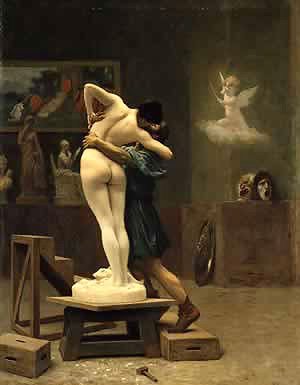Metamorphoses 10.238-297

This famous painting by Jean-Leon Gerome depicts the climax of Ovid's story of the sculptor Pygmalion and his creation. Here are some detailed questions about this story, which has inspired numerous artists and playwrights (note the theatrical masks in the corner of this painting):
- Who is the actual narrator of this story, and how does the narrator's own situation affect his attitude? Who are the Propoetides? What does sanguis induruit oris (line 241) mean, and how does it prefigure what happens to them? What is the effect of parvo discrimine (line 242)?
- How does the story of these women affect Pygmalion? What does offensus vitiis, quae plurima menti / feminae natura dedit (lines 244-45) mean? How does Pygmalion try to counteract these vitia through his art? Analyze the artistic way that Ovid uses words to evoke the sculptural artistry of Pygmalion in lines 247-49. What is notable about the beauty that he gives his creation (see this statue of Aphrodite from Melos that many observers have said the same thing about)?
- How does Ovid describe the statue in lines 250-51? What does ars adeo latet arte sua (line 252) mean, and why do many critics apply this phrase to Ovid's own work? What metaphor emphasizes the statue's effect upon its creator (line 253)?
- In lines 254-269, Ovid uses an excessive amount of description to characterize the excessive nature of Pygmalion's treatment of the statue; what are some of the lines that convey this best? Does this strike you as rather obsessive (not to say weird) behavior? Some Roman statues, however, were given jewelry, as this bronze statuette of Venus shows.
- What happens next? Analyze lines 274-276 to show how the meter, the sound patterns, and pauses, mirror the attitude of Pygmalion as he makes his prayer to Venus. How does Venus signal her acceptance of his wish?
- Ovid brilliantly conveys the gradual metamorphosis of the statue into a woman in lines 280-289. Point out some of the ways that he does this, referring to the Latin (note especially the prominence of the u-sound in lines 286-88). This illustration from a seventeenth-century German edition of Ovid does not begin to visualize the sensual scene that Ovid evokes through his words (Gerome's painting above does a better job).
- How does Ovid refer to the newly made woman in lines 292-94 (do we, for example, ever know her name)? Does she perfectly fulfill the purpose for which he originally created her (note especially the effect of the verb erubuit in line 293)? How does Ovid quickly wrap up the story in lines 295-97? Do you see any analogies with the modern film The Stepford Wives?